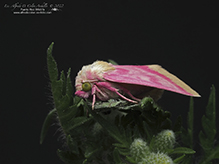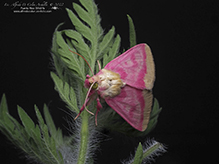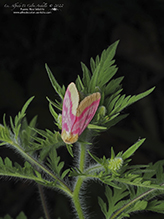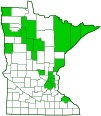primrose moth
(Schinia florida)
Conservation • Description • Habitat • Ecology • Distribution • Taxonomy
|
||||||||
| Hodges # | 11164 |
|||||||
Conservation Status |
||||||||
| IUCN Red List | not listed |
|||||||
| NatureServe | NNR - Unranked SNR - Unranked |
|||||||
| Minnesota | not listed |
|||||||
Description |
||
Primrose moth is a common, colorful, small to medium-sized, flower moth. It occurs in the United States from Maine to New Jersey, west to Minnesota and Illinois, and south along the Appalachian Mountains to northern Georgia. There are also isolated populations in Nebraska and Oklahoma. Outside of these areas, there are scattered reports everywhere except in the desert southwest. It also occurs in southern Canada from Nova Scotia to Alberta. It is most common in the northeast, less common in Minnesota, where it reaches the western extent of its main range. Primrose moth larvae are food specialists. They feed on the flower buds, not the leaves, of just a handful of species in the large genus Oenothera. These include common evening primrose, Nuttall’s evening primrose, northern evening primrose, tall evening primrose, rhombic evening primrose, and biennial beeblossom. Adults are active at night from late June to early September, a period that coincides with the blooming time of its host plants. They are found in meadows, prairies, fields, and roadsides, where their host species occur. They usually spend the day within the evening primrose corolla, which closes over the moth at dawn, leaving only the moth’s yellow wingtip exposed. Sometimes they spend the day perched on the stem of the plant, where their cryptic coloration resembles dead but still clinging flower petals. Adults are ⅝″ to ¾″ (15 to 19 mm) in length and have a 1 1⁄16″ to 1 7⁄16″ (27 to 36 mm) wingspan. The head is pink. The antennae on both sexes are thread-like. On the upper side of the thorax, there is a loose tuft of hairs and a pair of densely hair-covered, scale-like plates (patagia) that cover the wing bases. The tuft and the patagia are pale yellow. The undersides of the thorax and abdomen are pink. The forewings are mostly light to dark shades of bright pink. There is a rectangular, pale-yellow patch on the inner half of the basal area. The remainder of the basal area is often darker than the median area. The subterminal line is a broad band. It is often darker pink, and it is preceded by a narrower, pale-yellowish band. The circular (orbicular) and kidney-shaped (reniform) spots are usually darker pink. Beyond the subterminal line, the wings and the fringe are light yellow. The hindwings are uniformly creamy white. |
||
Size |
||
Total length: ⅝″ to ¾″ (15 to 19 mm) Wingspan: 1 1⁄16″ to 1 7⁄16″ (27 to 36 mm) |
||
Similar Species |
||
Habitat |
||
Meadows, prairies, fields, and roadsides |
||
Ecology |
||
Season |
||
One generation per year: late June to early September |
||
Behavior |
||
Adults are active at night and will come to lights. They spend the day in the evening primrose corolla or on the stem of the plant,. |
||
Life Cycle |
||
The female lays eggs on buds at the growing tip of a flowering shoot. No attempt is made to conceal the eggs between the buds or beneath flower petals. When the eggs hatch four or five days later, the larvae bore into the bud. They feed on the reproductive structures of the plant. Later stages (instars) bore into seed capsules to consume the developing seeds. Mature larvae drop to the ground, bore into the soil, and pupate. The pupae overwinter underground. Adults emerge the following spring in late June and July. |
||
Larva Food |
||
Flower buds of common evening primrose, Nuttall’s evening primrose, northern evening primrose, tall evening primrose, rhombic evening primrose, and biennial beeblossom |
||
Adult Food |
||
Flower nectar |
||
Distribution |
||||
|
Sources |
|||
| 12/9/2023 | ||||
Occurrence |
||||
Common |
||||
Taxonomy |
|||
Order |
Lepidoptera (Butterflies and Moths) | ||
Superfamily |
Noctuoidea (Owlet Moths and Allies) | ||
Family |
Noctuidae (cutworm moths and allies) | ||
Subfamily |
Heliothinae | ||
Genus |
Schinia (flower moths) | ||
Synonyms |
|||
Rhodophora florida |
|||
Common Names |
|||
evening primrose moth primrose moth |
|||
Glossary
Instar
The developmental stage of arthropods between each molt; in insects, the developmental stage of the larvae or nymph.
Orbicular spot
A circular spot or outline in the upper median area near the antemedial line on the forewing of many moths.
Patagium
In some mammals, the membrane between the forelimb and the abdomen that assists in flying or gliding. In Lepidoptera, one of a pair of hair-covered, sausage-shaped, scale-like plates on the thorax that cover the wing bases. Plural: patagia.
Reniform spot
A kidney-shaped spot or outline in the lower median area near the PM line on the forewing of many moths.
Visitor Photos |
|||||
Share your photo of this insect. |
|||||
| This button not working for you? Simply email us at info@MinnesotaSeasons.com. Attach one or more photos and, if you like, a caption. |
|||||
Alfredo Colon |
|||||
 |
 |
||||
 |
|||||
MinnesotaSeasons.com Photos |
|||||
|
|||||

Visitor Videos |
|||
Share your video of this insect. |
|||
| This button not working for you? Simply email us at info@MinnesotaSeasons.com. Attach a video, a YouTube link, or a cloud storage link. |
|||
Other Videos |
|||

Created: 12/9/2023
Last Updated:





